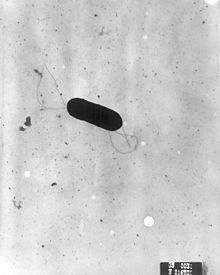
KNOWPIA
WELCOME TO KNOWPIA
Summary
The Listeriaceae are a family of Gram-positive bacteria that includes two genera: Listeria and Brochothrix.[1][2][3] They are short, rod-shaped bacteria that are aerobic or facultatively anaerobic.[1] Spores are not formed, but under stress these bacteria can form filaments.[1] Some species, namely Listeria monocytogenes, can cause human and animal listeriosis. While not all bacteria in the Listeriaceae family are considered a danger to humans, some are strongly associated with food borne illness or microbial spoilage, so they remain a topic of interest in agricultural industries.[1]
| Listeriaceae | |
|---|---|

| |
| Listeria monocytogenes | |
| Scientific classification | |
| Domain: | Bacteria |
| Phylum: | Bacillota |
| Class: | Bacilli |
| Order: | Bacillales |
| Family: | Listeriaceae Garrity et al. 2001 |
| Genera | |
|
Brochothrix | |
References edit
- ^ a b c d Mansell, Peter D. (2022-01-01), McSweeney, Paul L. H.; McNamara, John P. (eds.), "Infectious Diseases: Listeriosis☆", Encyclopedia of Dairy Sciences (Third Edition), Oxford: Academic Press, pp. 343–351, ISBN 978-0-12-818767-8, retrieved 2023-12-05
- ^ George M. Garrity; Vos, P.; Garrity, G.; Jones, D.; Krieg, N.R.; Ludwig, W.; Rainey, F.A.; Schleifer, K.-H.; Whitman, W.B. (September 15, 2009). The Firmicutes. Bergey's Manual of Systematic Bacteriology. Vol. 3 (2nd ed.). New York: Springer. p. 1450. ISBN 978-0-387-95041-9. British Library no. GBA561951.
- ^ Euzéby, J. P. "List of Prokaryotic Names with Standing in Nomenclature". lpsn.dsmz.de. Retrieved March 24, 2014.


